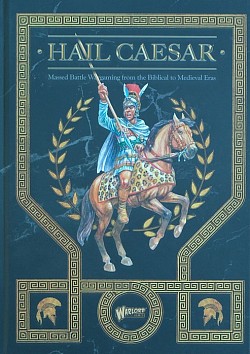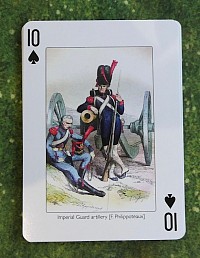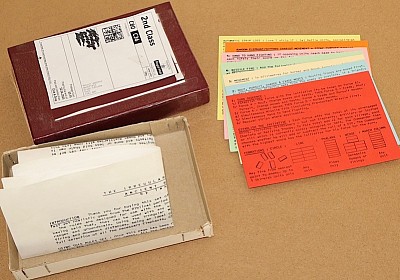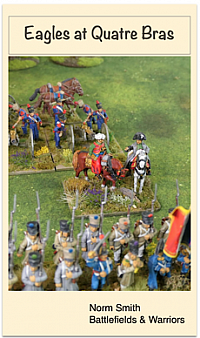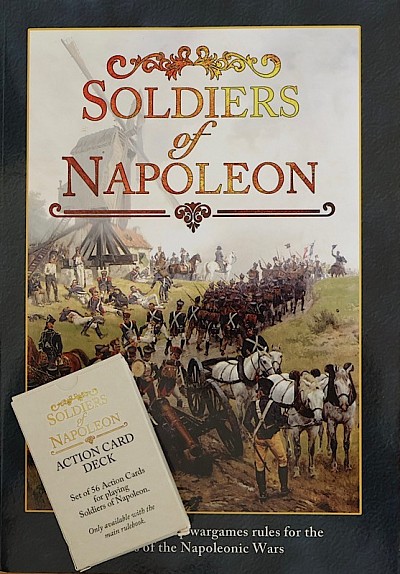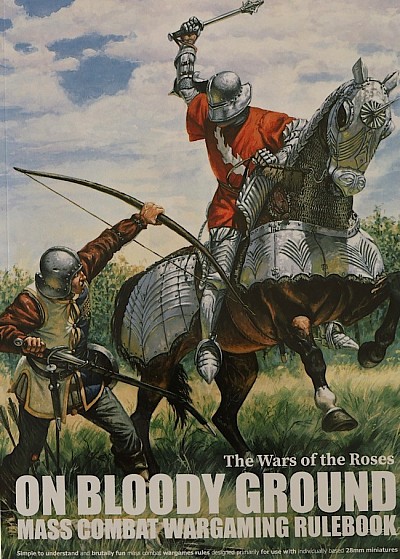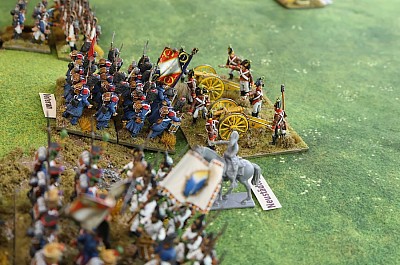Figure Rule Sets
A familiar trio
In trying to reduce the number of different rulebooks and systems in the collection, this related trio of rules from Warlord Games, taken together, cover a significant timeframe and benefit from inter-related systems … know one set and you already know 90% of one of the others!
So for good or for bad - there will always be divided opinion on these rules, I have settled on the trio of rules from Warlord Games to remain in the collection.
They share a game engine, but strive to be different
Hail Caesar - Now in its second edition, the time frame has been stretched forwards to also cover the Wars of the Roses, which usefully covers my 28mm WotR gaming and the Imaginations campaign from Piggy Longton.
The rules use the term ‘divisions’ as the organisational command level and so for us, we can view those four divisions as centre and two wings, plus any reserve or in Wars of the Roses terms, the vanward, mainward and rearward.
These seem quite well suited to dining / kitchen table battles with their infantry movement allowance of 6” and cavalry at 9” or 12” depending upon type.
Of the topics that I am currently interested in, Hail Caesar rules will deal with the Wars of the Roses and the Epic Punic Wars.
Pike & Shotte - for ‘Battles with model soldiers in 16th and 17th centuries’. This is another well illustrated rulebook from the Black Powder stable. I got mine on the re-print, so it is soft cover rather than hard cover which is a shame, I would have happily paid more for the extra protection.
There are six scenarios that cover the Italian wars, 30 Years War, English Civil War and the War of the Grand Alliance, though it is really only the ECW that interests me from a play point of view (at the moment!).
I also have the ‘To Kill a King’ supplement, which is a superb resource for scenarios of some of the lesser known and small battles of the ECW.
There are the usual array of ‘useful rules’, which in effect are unit attributes that reduce the generic nature of the rules, for example Caracole and hedgehog attributes.
Infantry are moving 6” though of course they may get three moves in a turn, however that movement rate is tame enough for a 6x4 table without having to half measurements etc ….. though as with Hail Caesar, the cavalry are much more nimble at 9” and 12” for light cavalry.
There was an early criticism of the rules in that they tended to allow the pike and musketeer elements of a formation break off and go on their own little ‘jolly’. The To Kill A King supplement dealt with that by having ‘Combined Units’, which by keeping the elements together, allows the unit to benefit from the ‘Pike Company’ special rule that essential aids the unit if attacked by cavalry.
The recently released ‘Epic’ Pike & Shotte box included a Pike & Shotte rule book specifically modified for the Epic scale. The sprues in that box allow for either ECW or 30 Years War armies to be built and I propose at some point to build the former.
Black Powder - These rules break with the other rules by having greater movement allowances with infantry allowed to move 12”, so if they get three moves in a turn, that is a whopping 36” and consequently, I would consider using half movement conversion with BP on a typical domestic table.
However, the ACW Glory Hallelujah supplement has a rule that states if a unit uses more than one movement in a turn, it cannot fire in the next phase and that can significantly dampen down the enthusiasm to move too far and this is a rule that would serve well other periods in the Black Powder time frame. I can’t understand why it never made the 2nd Edition Black Powder as a core or even optional rule.
The Clash of Eagles is another nicely done BP supplement, this one covers the invasion of Russia 1812, but my favourite supplement is Rebellion, a book worth owning in its own right for anyone interested in the American War of Independence.
Prime use of the rules for me will be Napoleonics and American Civil War. At some far future point, I would like to think that I could get a couple of AWI armies, but there are other more pressing matters at the moment.
The Epic version of Black Powder is now out for both ACW and Napoleonics and usefully, a separate scenario book was released for Waterloo (The Hundred Days) that contains 19 Waterloo campaign based scenarios plus an extensive order-of-battle.
World War II tactical
Perhaps seen as an old school ruleset (which brings a certain charm of its own), Rapid Fire has just been one of those systems that has been solid enough to remain popular for more than 25 years.
It stays with a predominantly IGOUGO sequence of play, while it could be argued that these days, the modern gamer is drawn to something a bit more inter-active or unpredictable, such as variable unit activation.
It has recently had a shot in the arm through its newest version of the rules …. ‘Reloaded’, which is a more streamlined version of the original, making play a little slicker.
The Reloaded basic rules cost just a fiver and come in a lovely little A5 16 page booklet and there are now a growing number of similar A5 supplements, containing mainly scenarios, that are just a pleasure to own.
The picture to the left shows the booklet art that gives us four Canadian actions, each presented for a helpful 6x4 table in the 20mm scale, so smaller scales can keep the same measurements or use a smaller table.
The most recent release covers four battles in north west Europe involving the Sherman Rangers Yeomanary called ‘Brothers in Armour’, inspired and developed in association by Tom Holland and his book ‘Brothers in Arms’.
Valour & Fortitude
These rules from the Pen of Jervis Johnson are a free downloadable set from the Perry Miniatures website.
Jervis was an author of the Black Powder rules and V&F came about because his gaming group wanted an easy four page fast play system for big games at game conventions, so that games would actually move along.
They have been refined over the past couple of years and it is the authors view that the game engine is stable enough to cover a wide range of periods and that it is the army lists themselves that will drive the period flavour.
They started with Napoleonic lists and have already explanded to cover ACW, the Franco-Prussia war and have gone back as far as the English Civil War, so there is plenty of potential here.
Part of the flavour also comes from a Fate Deck, built from ordinary playing cards (the image above is from my Napoleonic playing card set) and this brings some chaos / random events to play.
I play the rules with two tweaks. Firstly using my Epic scale figures, I dropped all measurements to ⅔ and that looked right and seemed to work rather well.
Secondly, I don’t like card play that builds up a ‘hand to be played’ with the inevitable ‘Gotcha’ type moments that fall out of that. I do however like the Random Event nature of the cards so I kept them in the game, but instead of allowing a hand to build up, in the Fate Phase, the next card is simply turned and played by the player that turn - or lost! It seems to work fine.
I quite like the Double Move action as that does bring the sides into closer contact much faster and allows the game to get going properly. I also like the support rules that allow nearby unit to contribute to a units fighting strength, both for firing and melee. It feels a sensible half way house from allowing units to simply gang up.
I found the Rally rules to be suuitably tame and more often than not will mainly be allowing units to recover enough strength back that they stop being shaken. It feels natural to do this when units consolidate a position that they have just taken, as they catch their breath and I suppose in part, it reflects re-organising the ranks and getting some cohesion back.
I do like that the system makes the action across the table feel like it is being conducted by separate brigades, so that even on a small table there is a sense of several different points of crisis emerging for one side or the other.
As the author of Black Powder, it is very interesting to see Mr. Johnson's evolution of thinking in these rules, particularly in keeping unit fire power very separate from then conducting Actions.
Old School Ancients
I initially had this rule set in the late eighties and noticed that Irregular Miniatures still had some copies, so one was duly ordered. Postie has just delivered it and I take in a deep breath of nostalgic anticipation as I open the box.
Amidst my high excitement, there is a small immediate disappointment …. The box has been sent by putting a postage label on the actual box and taping it down, which now detracts a little from the pleasure of the box. I would have preferred the whole thing to be put in Jiffy bag and if I order the other sets I will ask for that.
Anyway, everything else is just a simple joy and mostly as I remember it.
There is an information sheet of A4 paper in the box that is printed to both sides. Interestingly, at the footnote there is a copyright date of 1989, which surprised me, I thought they were earlier. But that is still 36 years ago, so this is an old original set, rather than a newish reprint, so the box is a little tired (it was posh in its day with a sort of leatherette finish) and the type face and the hand drawn formation diagrams speak with an 80’s voice …. I like that, but date wise, it is interesting to see that the rules sit on the cusp of old school and modern in terms of ideas.
This is really exemplified by the two systems (you choose which one) for recording casualties. System 1 - the unit is built from a number of 6mm strips and you remove a strip to show casualties or cohesion loss. This harks back to old school single figure removal from units. System 2 - you make up a base for the unit and on a roster, assign strength. Reductions to strength are made on the roster, which is close to how we would do things today, though perhaps with dice or markers to show losses.
A couple of other things that might have felt modern in the day, measurements are in centimetres rather than inches and morale classes have different die roll strengths, so for example Class C (average warrior) use a D8, raw troops a D6 etc - that still feels a fairly modern mechanic to me.
The box is roughly 100mm x 140mm and 20mm deep. The cards inside are a snug fit and carry the entire system. They are colour coded to match the sequence of play. They have the charts, process and modifiers etc on the front face and associated notes and examples on the back. I seem to remember playing without any problems, so it will be interesting to see if a modern eye that is used to finding errata in games will now find questions … an interesting subject in its own right.
Anyway, back to the sheet of paper. It broadly sets out what the game is about, describes the nature of unit types by their function (i.e. skirmishers), draws a distinction between regulars and irregulars and sets out four morale classes from raw to elite.
They include a points system for non-historical battles and set a scale of 1mm = 1 yard for 6mm figures and 1mm = 2 yards for their 2mm figure range (yes I know, a mix of metric and imperial), but emphasise that other figures scales can be used with relevant changes to ground and weapon range scale. They suggest that the notes on the leaflet need only be read a couple of times and then not reference again for play - everything else is done with the cards.
The colour coded cards follow the sequence of play, so;
RED - Summary of the turn sequence, Initiative and formation examples
(Rear - scouting and dispositions, orders (orders can be changed if a general joins a unit).
BLUE - Rout, Pursuit, Charge and Evade
(Rear - examples)
PASTEL YELLOW - Movement (veering, rough terrain, obstacles and limitations)
(Rear - notes and examples)
GREEN - Missile Fire with modifiers and ranges
(Rear - examples)
PINK - Hand to hand fighting, there are 3 rounds (1 round per turn) to try and get a winner, after 3 rounds, if a winner not established (doubtful I think) the fight has fizzled out and the side with weaker morale side breaks contact.
(Rear - defines rear support and examples)
ORANGE - a diagram of random directions (D12) for Random elephant / scythed chariot movement and stone thrower ranging.
(Rear - the diagram explained)
BRIGHT YELLOW - some mechanic notes like how strips can be automatically lost if moving through rough terrain and the PANIC TEST procedure
(Rear - examples)
All told, there is a fair amount of rules ground covered here and I do remember getting a good game, so I am hopeful that that remains the case. What is really helpful is that when you are in a particular phase, that is the card you have in your hand and all of the information is there - you are not rummaging back and forth in a rulebook looking for related items as questions crop up. I guess it is either on the card or you are stuck and guess what ….. we can try and work it out for ourselves rather than the modern way of going straight onto the internet and asking the community / designer for an answer that 90% of the time is ‘there’ (or toss a coin as the paper leaflet helpfully suggests).
Note the author (Ian Kay of Irregular Miniatures) kindly included his phone number and said anyone if really stuck could call him during office hours … the pre-internet solution :-).
One thing that I didn’t remember was that units are given initial orders - only to be changed by the general attaching themselves. At first I though ‘orders’ - oh that’s a bind, but then as I think about that, I quite like it, it will ensure without a ton of rules overhead that the armies of the period are difficult to freely manoeuvre once battle gets going …. None of the fancy foot work that might be more in keeping with a WWII panzer formation!
I will taking these for a spin with my (unpainted) Epic Hannibal set, but on on reading the examples, they include actions will bill and bow, so they likely have the same spread of cover as most ancients rules of the day, that is to late medieval (1485), so my War of the Roses 28mm will also get taken for a spin.
Irregular Miniatures have been present in my hobby world since day one and I admire them for the years that they widely supported the show circuit and made figure collecting accessible to the masses, thank you Ian and team.
Home brew rules
I have three sets of my own rules, each of which are fairly well developed and quite tight.
Into Action - is a WWII tactical set. Each base is a rifle section, a support weapon or an individual vehicle. A game with typically see a company of infantry on a side with support, so perhaps just two or three vehicles.
They use a game clock, so each turn 2D6 are rolled and the ‘game clock’ is advanced by that many minutes. The clock will determine the end of the game and also the point at which any reinforcements etc arrive.
For the infantry, the first hit pins them. A pinned unit that is then hit is removed from play. Units can recover from a pin on a test, doing better if they are in cover!
I like to think that some care has been taken with the ‘to hit’ and penetration engine for armour and that outcomes are not too out of wack from our gaming of reality.
Command and control is present and a morale clock ticks downwards as casualties and losses occur. When the clock hits zero, everything on that side tests and if failing are forced to retire. This can cause attacks to fizzle out and disrupt even the best looking defensive lines, creating both opportunities and disappointment.
The picture above is an oil painting that I did some years ago to give me a cover for the rules that didn’t infringe any copyright.
Eagles at Quatre Bras
Eagles at Quatre Bras - is of course my Napoleonic set. It started out life quite different and much simpler than the current version, but I have tried to merge the engines of these rules and my ACW rules, which were more advanced and I am happy with the transition.
In my games, cavalry do not have high movement rates. I don’t think they spent forever dashing around the field, so it is only when they charge that you see a movement enhancement, plus once per game, they can dash off ‘somewhere’!
Units cannot charge on two consecutive turns …. Things with lungs need a breather between bouts of dynamic activity.
Units take losses which after a while will degrade them. Then there comes a point when they need to test each turn due to excess loss and lack of cohesion, failed tests cause the unit to fall back and take a further loss.
It all rather develops a momentum of its own. So units generally have an offensive ability, then tend to be more happy defending and then start to fall back and want to be somewhere else, where there are fewer musket balls flying around!
Two Flags - One Nation
Two Flags - One Nation - these are my ACW rules and have probably been around the longest. All that has been said of Eagles at QB can be said here.
We obviously have some longer weapon ranges and units will tend to firefight rather than close for combat unless the enemy looks like they are in the mood for giving ground through losses and disorder. Horses certainly do not want to move against all that ranged firepower.
Various activity adds a disorder counter to a unit and these accrue, though regardless of how many counters you have you still only pay the penalty of simply being disordered. Where all the extra disorder matters is in the phase that the unit rolls to lose its disorder, obviously the more disorder a unit has, the harder it is to lose it all in one go, so in effect, we might see a unit that is ‘very’ disordered compared to one that is less so.
The skirmish rules are less involved than with the napoleonic set as virtually all units can make use of open type order, though the ability of units to both change formation and move in the same turn is subject to testing of unit ‘Capability’.
There are many instances in the rules of testing capability and at times I have wondered whether the mechanic relies upon too many die rolls, but as units degrade through loss, these tests become more critical and in my view help with the narrative of the game.
The engine used to have a game clock, but it wasn’t so effective here. Too many things defaulted to 15 minutes time slots and administratively it just made more sense to have traditional game turns based around those 15 minutes.
I have had one copy of all three rule books properly printed at a ‘print on demand’ service so that I am gaming with a ‘proper’ rule book and that adds a nice touch. Notes are added to these, but these days there is less red ink going onto those pages after each play, so they must be getting tighter. Once there are too many notes, I get a new version printed off - a rather luxurious thing to do, but why not :-)
Soldier's of Napoleon
Through the post box today, A Napoleonic ruleset - Soldiers of Napoleon.
This has been out for a while and though I have been interested, the fact of it being card driven, has always made this seem not the game for me ..... however;
I have been watching a few videos, particularly the one by Wargames Illustrated Magazine, where they interview and game with the author and my interest had been tickled enough to put an order in.
Two headline aspects are 1. Your battle with 2 - 5 brigades on a side is actually sitting within a larger engagement and things that are happening off table (i.e. to your flanks) may come to influence your game - the cards bring some of this narrative.
2. The cards are used rather like those in the boardgame 'Commands and Colors' - each card has a value for orders that can be given to a brigade for its various battalions to act OR it can be played for its special event (such as - Fierce Cavalry Charge) OR it can be played for its rally value.
So far, those who I have come across in reviews seem only to have good things to say about it all and I think part of that may be because the system offers something different, plus narrative type rules are becoming increasingly popular.
Anyway, we shall see. The company (Gripping Beast) have two download campaigns that could be used with my French / Austrian pairing, one for Wagram and the other for Austerlitz, so they are on the list.
In the meantime the rules do include stats for the Austrians in the War of the 6th Coalition, so I will do a bit of practising in that setting for now - hopefully I will like the rules. there is a bit of reading and a learning curve to go through, but my enthusiasm is high.
Stand alone Wars of the Roses rules.
Since starting the Wars of the Roses collection I have migrated from Sword & Spear rules, to Never Mind the Billhooks to Hail Caesar. Each getting me closer to what I want from the tabletop game.
The Hail Caesar rules are fine and I have just bought the WotR supplement from Warlord Games, which is fabulous, but my eye has caught something twinkly!
Call me shallow, but lovely artwork on a rule book can open my wallet and so it is here. On Bloody Ground is a series of rules written by David & Daniel Toone and published by WiP Games and Miniatures. They already have several volumes out covering such things as Caesar and the English Civil War. Each volume shares a common game engine, but is specific to the period and here we are looking at The Wars of the Roses.
It is an A4 format, softback, glue bound with 64 pages including a comprehensive index. There is a lot of information on army building, with 5 distinct armies being focused upon: Yorkist, Lancastrian, Richard III, Henry Tudor and the Yorkist Pretenders.
There are no scenarios, but there are sections on choosing ground and deployment. In one way they exemplify the club throw down game, but in another, the army building around points looks like it might take some effort to get the forces and their various attributes recorded, but they will give something with some character and flavour.
The rules are basically held in 22 pages, but then there are another 10 pages of definitions and explanations that support the rules. I like that there is 1 page on shooting, 1 page on movement etc, it gives the air of simplicity and ease, but there is some initial hunting to do. For example, in shooting I could not find the range for weapons, even though it mentions a long range modifier, but turn to the weapons section and we see that English longbowmen have a range of 30", standard bow 24" and heavy crossbow 18".
The only thing that catches my curiosity with this initial browse through the book is that compared to missile range, movement seems quite slow. I'm sure this will work out right during play and when all the rules are assimilated, but it has grabbed my attention and will be a thing that I give early thought to.
I can see these being tested early at the table. As I say, I have no particular reason to move on from Hail Caesar, but for £13, these self-contained rules are interesting and there is something about the non-colour fancy pants contents that just feels a bit less commercial and more like the rules that I had in my younger days .... yes, a nostalgic thing, but that is not to be dismissed too lightly.
I am reminded of 'Flower of Chivalry' by the Canadian Wargame Group, not in terms of actual content, just in terms of joyful charm. More on this soon,
Taking Soldiers of Napoleon for a spin
I had a very pleasant afternoon today with the 28mm Napoleonics giving the Soldiers of Napoleon a run through on the table.
A full description of my initial observations are now up over on the Battlefields and Warrior Blog at the below link.
The photo here is of French infantry suddenly appearing over a crest and charging down into the Austrian guns below the lower rear slopes
Link
https://battlefieldswarriors.blogspot.com/2025/10/a-dipping-toe-soldiers-of-napoleon.html
